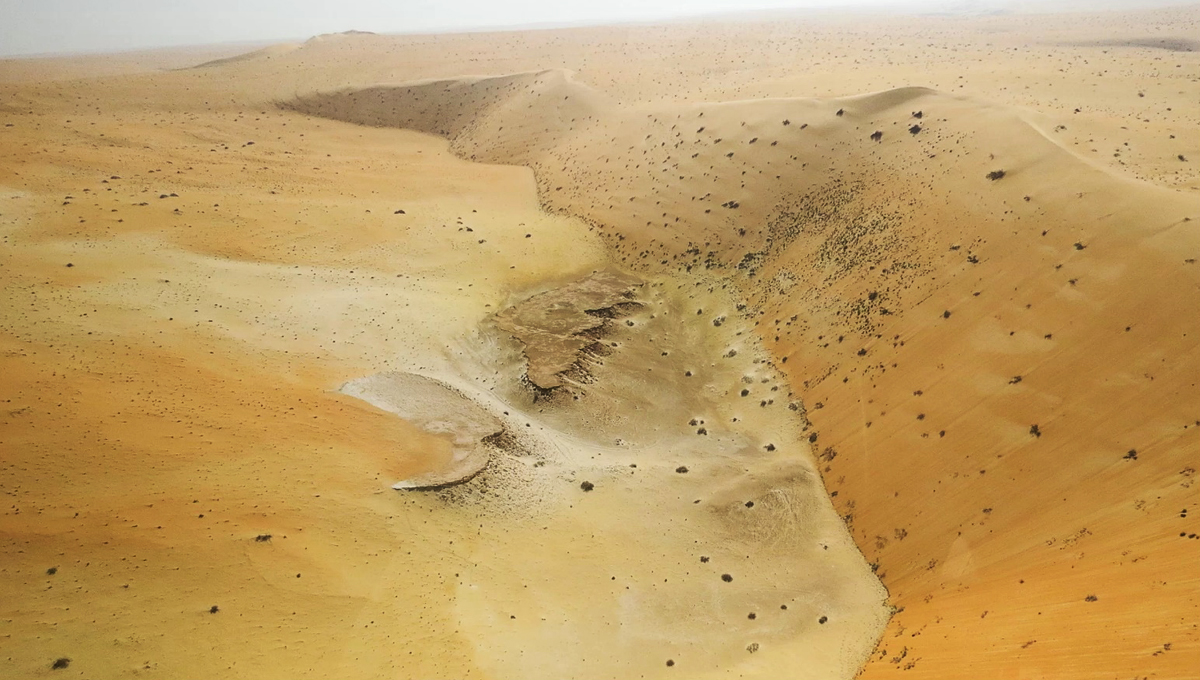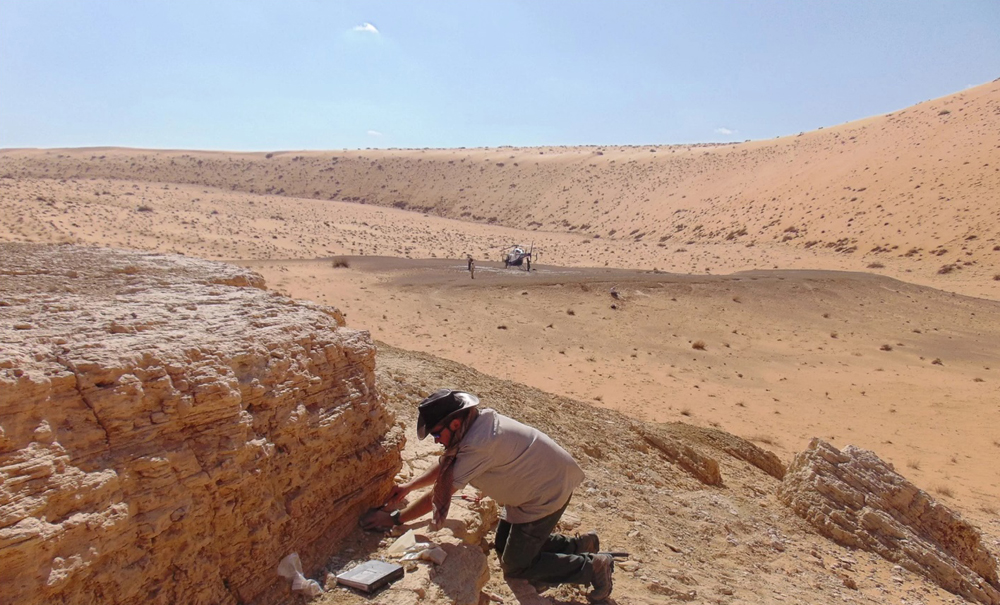


An article by Live Science Contributor Owen Jarus on livescience.com - 46 Prehistoric Sites with Palaeolakes Discovered in 'Green Arabia' - reports on the 46 sites containing artefacts discovered beside the remains of ancient lakes in the western Nefud desert in Saudi Arabia.

The Nefud desert today, with palaeolake sediments exposed between dunes. Image: Palaeodeserts Project/Max Plank Institute.
Some of the stone tools date to the Lower Palaeolithic period. Animal fossils, including fossils from now-extinct forms of jaguar and elephant, were also discovered at some of the sites.
The discoveries point to the 'Green Arabia' when the climate in Arabia - the area spanning modern-day Saudi Arabia, Yemen, Oman and other Gulf States - was wetter, supporting more vegetation and wildlife than it does today. Researchers believe it also supported early humans.
Ancient Lakes of a Green Arabiahttps://t.co/63nfiGIQs9 #archaeology #PalaeodesertsProject #SaudiArabia pic.twitter.com/NQwguQB8cL
— Bradshaw Foundation (@BradshawFND) August 2, 2017
The Palaeodeserts Project research team in the Nefud desert. Image: Palaeodeserts Project/Max Plank Institute.
Paul Breeze, a landscape archaeologist and research associate at King's College London and part of the Palaeodeserts Project, states that these repeated wet phases affected much of Arabia and were driven by periodic variations in the Earth's orbit and axis, causing the monsoons to move north into Arabia and into the Sahara. Between these wet phases, Arabia was as arid as it is today.
The Palaeodeserts Project aims to better understand Saudi Arabia's environmental and human history, bringing together researchers from the Saudi Commission for Tourism and National Heritage, the Saudi Geological Survey, Saudi Aramco and scientists from all over the world.
Searching for ancient lakes - researchers examined high-resolution satellite and aerial imagery, as well as geological maps. Focusing on a section of the western Nefud desert, they found that many of these so-called paleolakes were located in basins between sand dunes. Paleolake sediments were analysed and then excavations followed.

Working in the Nefud desert. Image: Palaeodeserts Project/Max Plank Institute.
Published in the journal Archaeological Research in Asia, the research reveals how life changed in the western Nefud desert: Lower Palaeolithic hominins could, at times, have experienced widespread favourable environmental conditions. Previously reported research suggested that around 200,000 years ago, after the Lower Paleolithic, modern humans (Homo sapiens) might have used Arabia as a corridor to migrate out of Africa. The new findings suggest that, at that time, humans (whether Homo sapiens or other human species) appear to have been venturing deeper into the western Nefud desert and were no longer sticking to the fringes.
The archaeological sites did not reveal artefacts that dated to the Upper Palaeolithic or Epipalaeolithic, between roughly 40,000 and 10,000 years ago, suggesting that the western Nefud had become more arid and less capable of supporting life by that time.
The last 'wet period' seems to have occurred between roughly 10,000 and 6,000 years ago. Following this the climate became increasingly arid. However, humans were still able to venture deep into the western Nefud desert because they had domesticated the camel.
Visit the Rock Art of Saudi Arabia Archive:
http://www.bradshawfoundation.com/middle_east/saudi_arabia_rock_art/index.php
by Bradshaw Foundation
Monday 04 December 2023
by Bradshaw Foundation
Friday 30 June 2023
by Bradshaw Foundation
Thursday 06 April 2023
by Bradshaw Foundation
Thursday 24 November 2022
by Bradshaw Foundation
Tuesday 27 September 2022
by Bradshaw Foundation
Thursday 08 September 2022
by Bradshaw Foundation
Tuesday 19 July 2022
by Bradshaw Foundation
Monday 06 June 2022
by Bradshaw Foundation
Friday 11 March 2022
by Bradshaw Foundation
Wednesday 02 March 2022
by Bradshaw Foundation
Thursday 26 August 2021
by Bradshaw Foundation
Monday 16 August 2021
by Bradshaw Foundation
Tuesday 06 July 2021
by Bradshaw Foundation
Thursday 06 May 2021
by Bradshaw Foundation
Thursday 06 May 2021
by Bradshaw Foundation
Tuesday 16 March 2021
by Bradshaw Foundation
Monday 04 December 2023
by Bradshaw Foundation
Friday 30 June 2023
by Bradshaw Foundation
Thursday 06 April 2023
by Bradshaw Foundation
Thursday 24 November 2022
by Bradshaw Foundation
Tuesday 27 September 2022
by Bradshaw Foundation
Thursday 08 September 2022
by Bradshaw Foundation
Tuesday 19 July 2022
by Bradshaw Foundation
Monday 06 June 2022
by Bradshaw Foundation
Friday 11 March 2022
by Bradshaw Foundation
Wednesday 02 March 2022
by Bradshaw Foundation
Thursday 26 August 2021
by Bradshaw Foundation
Monday 16 August 2021
by Bradshaw Foundation
Tuesday 06 July 2021
by Bradshaw Foundation
Thursday 06 May 2021
by Bradshaw Foundation
Thursday 06 May 2021
by Bradshaw Foundation
Tuesday 16 March 2021
Friend of the Foundation











